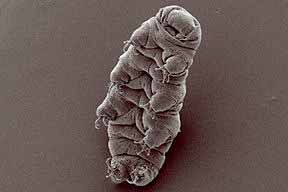|
CHANDRA WICKRAMASINGHE SAYS SURVIVAL OF
‘WATER BEARS’ IN SPACE STRENGTHENS HIS THEORY OF PANSPERMIA
By Walter Jayawardhana

tardigrades (water bears)
The European Space Agency scientists’ discovery that tiny insects
have survived during a space journey of ten days despite huge doses
of radiation has blown new breath into the theory that life could have
travelled from outer space to earth, proposed by Sri Lanka born scientist
Professor Chandra Wickramasinghe.
Wickramasinghe said in an interview , "I think this finding goes
a long way towards proving that we are truly creatures of the cosmos.
If life evolved on the Earth in isolation from the rest of the Universe
there is no need for such remarkable space survival attributes to develop.
Obviously, humans and cows cannot survive an unshielded journey in space.
But for bacteria the situation is different, and now for even for some
types of small insects interplanetary transport appears to be possible."
Last week scientists at the European Space Agency have reported that
a millimetre sized insect species called tardigrades (water bears) have
survived a journey in outer space for some 10 days. These tiny 8-legged
creatures occupy almost every watery abode on Earth and can survive
intense pressures, huge doses of radiation and years of desiccation.
Now they have been found to survive a space journey.
Chandra Wickramasinghe, a pioneer of the modern theory of panspermia,
welcomed the new data and said that it might even prove that insects
came from space some 250 million years ago. He said, “New results
are coming in thick and fast all of which support the ideas that Fred
Hoyle and I championed 30 years ago. At the time we were thought to
be heretics! It's time now for the scientific community to go back and
look at our writings and admit that we were right."
Panspermia is an ancient idea asserting that life seeds are distributed
throughout the cosmos. But the modern versions of the theory can be
traced back to the pioneering work of Sri Lankan born scientist Professor
Chandra Wickramasinghe and his collaborator the late Sir Fred Hoyle.
Throughout the 1970’s and 1980’s they developed the theory
and its implications with meticulous care, writing over 25 books and
some 300 scientific papers. They showed how life can be spread within
the solar system and from star to star in the galaxy. At the time mainstream
scientists were loathe to accept these views, often taking little notice
of their work.
Over the past decade evidence has mounted steadily in support of the
general concept of panspermia. It had been once argued by critics that
panspermia cannot work because microbes cannot survive under the harsh
conditions that prevail in space. Now we know that some microbes on
the Earth survive the harshest conditions imaginable and have all the
attributes of space travellers. Microbes are known to inhabit the interiors
of nuclear reactors, the dry valleys of the Antarctic, and geothermal
vents (hot springs).
In the last few years experiments have been done showing that micro-organisms
and lichens survive direct exposure to the conditions of outer space.
Now the same space hardiness has been established for a millimetre sized
insect species.
Wickramasinghe and Hoyle argued that comets in the solar system are
the main repository of life and that injections of material from comets
led to the start of life on the Earth. But comets are with us still
and comets continue to inject material that is potentially laden with
life. The possibility that evolution of life on the Earth is modulated
by such continuing injections was discussed in a book “Evolution
from Space” published by these authors in 1980. In this book Hoyle
and Wickramasinghe have a chapter 8 entitled “Insects from Space”
in which they speculate that frozen eggs of insects or even larvae may
be transported across the solar system. They wrote:
“Keeping the size small has many advantages. It removes what would
otherwise be a serious uncertainty for larger creatures, the strength
of gravity in the unknown environment. Insects are almost immune to
the strength of terrestrial gravity. They can ride in the wind to the
summits of the highest Himalayan peaks. Gravity could be a half, or
twice, what it actually is, without insects being embarrassed by the
change. Keeping size small provides insects with their most important
weapon, the ability of exist in very large numbers, almost “astronomical”
numbers…….”
On the Earth, the earliest appearance of insects seems to be at 250
million years ago. It is possible that these came as “water bears”
in the frozen matrix of a watery comet, Professor Chandra Wickramasinghe
said.
"It has always been a puzzle to understand how certain life-forms
like insects appeared suddenly in the fossil record. Now, perhaps, one
could make out a case to say that they came from space, possibly in
a frozen chunk of an icy comet,." He said.
|
